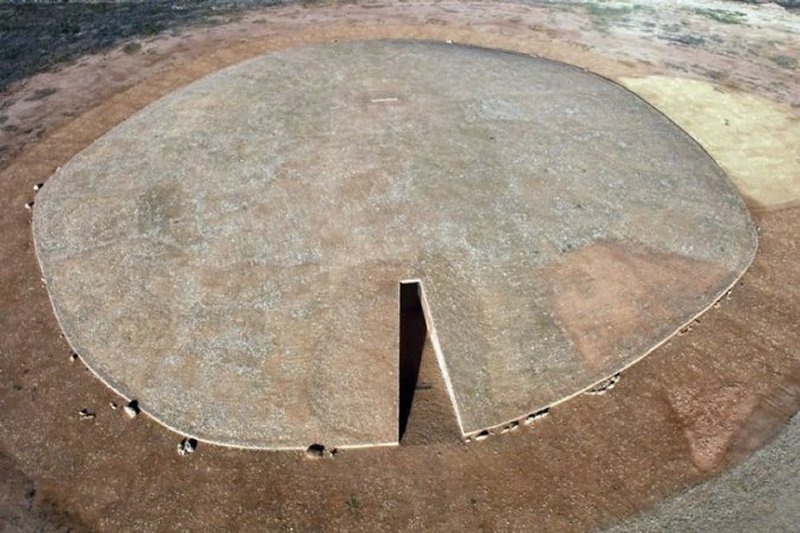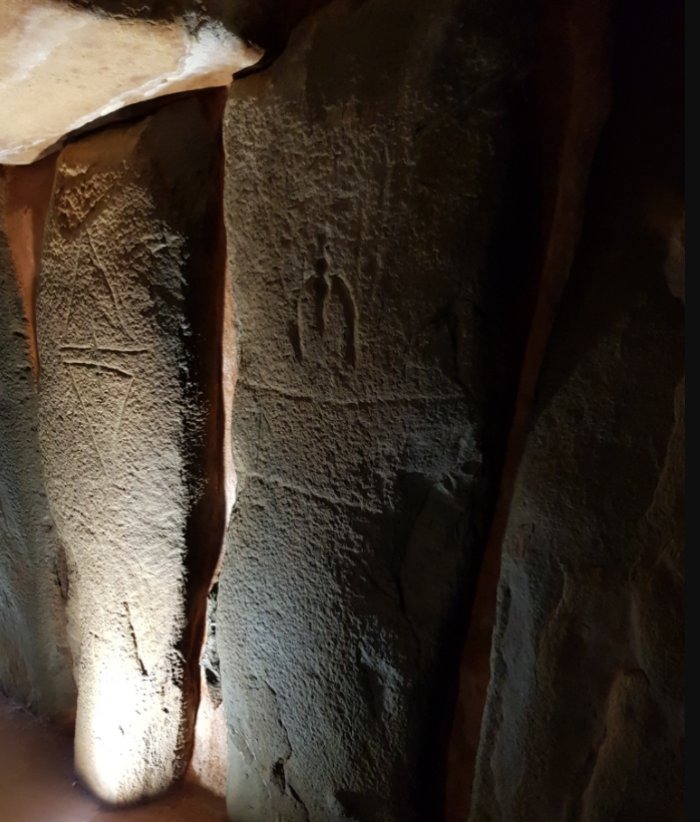Among the more than two hundred megalithic structures discovered in southwestern Spain’s province of Huelva, there is one particularly impressive and, at the same time, mysterious and puzzling.

Dolmen de Soto in Spain. Credit: Diario de Huelva
A giant millennia-old underground structure known as Dolmen de Soto, buried beneath a mound 60 meters in diameter, is often referred to as Spain’s underground Stonehenge and one of the most extensive circular megalithic arrangements in Spain.
Its ancient history is fascinating, and thanks to modern techniques, scientists have discovered ancient drawings on the stones and many display figures armed with daggers, staffs, and axes. Interestingly, based on the investigation of Dolmen de Soto, no other single megalithic structure in Europe contains so many well-armed figures.
So the question is: Were these ancient people frightened of someone or something?
What Was The Purpose Of Dolmen de Soto?
Recent archaeological excavations also revealed and documented the existence of a Neolithic stone circle with a diameter of 65 m that now dates to 5,000-4,000 BC.

Inside Dolmen De Soto. Credit: IAPH
The circle’s building was created of stones varying in size and shape. An underground passage, measuring 21.5 meters, starts narrow and then extends to three meters in width and height as it reaches the back of the monument. Inside, a gallery consists of 63 stone pillars, a frontal slab, and 30 other stones covering it.
What was the purpose of Dolmen de Soto? Was this great megalith a sanctuary for the cult of death? Or perhaps it was a place of reverence of important gods and other divinities?
Was it a graveyard? If so, why were only a few people buried in this big underground complex? How was it constructed? There are many questions, but not all of them have clear answers.
As many as 69 granite pillars – dated between 3000 and 2500 BC – line the walls. The Dolmen has an anthropomorphic stele with a human face, belt, and trident, similar to the Dolmen on the Channel Island of Guernsey.
The structure was discovered and excavated by Armando de Soto in 1923. Hugo Obermaier investigated its architecture, an enormous quantity of engravings, and various stelae used more than once.
Dolmen de Soto is astronomically oriented towards the east and perfectly matches the sunrise at the spring and autumn equinoxes. The first rays of the sun at the equinox appear through the corridor and are projected on a particular chamber located at the eastern end of the Dolmen’s passage. It suggests that the ancient people had a symbolic rite by which the deceased was reborn, experiencing sunlight.
The underground structure of the long corridor dolmens family is the most extensive megalithic facility in the Huelva province. It is almost 21m long (ca 69ft), though its width varies from 0,82m at the door up to 3.10m (10ft).
Inside the mound, experts found a metalworking workshop dating back to 3,000 BC, indicating that the weapons’ drawings are most probably related to the discovery of metallurgy.
Additionally, the researchers discovered only eight bodies buried in seven different places inside the Dolmen. The bodies appear crouched near the wall and have orthostats (large rock boulders, known as uprights) decorated with a few engravings showing the image of the deceased, his protecting totemic sign, or some of his weapons.
Today, we know much about Dolmen de Soto (also known as Soto Dolmen), but still, much is missing. Doubtful, the mystery of this significant Neolithic landmark will be solved even with modern techniques.
The problem is that the eight bodies buried in seven different places inside the Dolmen are missing!
The bodies and belongings were taken from Dolmen de Soto and transported to the United Kingdom. Their whereabouts are unknown.

Dolmen de Soto, Trigueros. Image credit: Hostal Ciudad Trigueros – CC BY-SA 4.0
Professor of prehistory Mimi Bueno-Ramírez, at Alcalá de Henares University in Madrid, was right, saying: “if we had access to the ancient bodies found at the site, we could learn more about this fascinating place. It’s a pity these human remains and artifacts were never analyzed.”
A part of Dolmen De Soto’s history was lost.
Paintings Engravings Drawings And Symbols
Dolmen de Soto contains a rich collection of painting with symbolic motifs and engravings created with the help of various engraving techniques like incision, low relief, abrasion, and picking.
This rock art is our ancestors’ artistic manifestations of cosmology, visions of the world and sky with stars, sun, and moon. Inside Dolmen de Soto, these observations and concepts are expressed through symbols.
Some symbols tell stories about rituals linked to death and the afterlife because they helped them connect the material world with the spirits. Other characters in the Dolmen are related to beliefs, myths, and legends.
As we do today, our ancestors also pondered the concept of possible life after death or whether death ends their existence and represents the gateway to an afterlife.
Dolmen de Soto resembles Stonehenge, and the same ancient builders constructed those structures to a certain degree.
Did Stonehenge look like the Dolmen de Soto? Maybe there is no connection between these two prehistoric sites, but these are questions worth pondering for a curious mind seeking answers.








